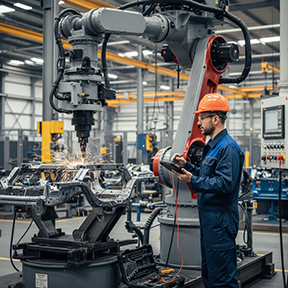Published: November 06, 2025 | Updated: October 31, 2025
Published: November 06, 2025 | Updated: October 31, 2025
Preventive Maintenance Inspections That Keep Assets Performing
 Preventive maintenance inspections that keep assets performing play a critical role in protecting and extending equipment life, and reducing costly breakdowns. Across industries, organizations rely on inspections to maintain safety, compliance, and consistent output. A computerized maintenance management system (CMMS) strengthens these inspections by organizing schedules, storing data, and creating accountability. The following discussion highlights 20 essential inspections, industry applications, and the benefits of using a CMMS to support these tasks.
Preventive maintenance inspections that keep assets performing play a critical role in protecting and extending equipment life, and reducing costly breakdowns. Across industries, organizations rely on inspections to maintain safety, compliance, and consistent output. A computerized maintenance management system (CMMS) strengthens these inspections by organizing schedules, storing data, and creating accountability. The following discussion highlights 20 essential inspections, industry applications, and the benefits of using a CMMS to support these tasks.
Why Preventive Maintenance Inspections Are Vital for Equipment Reliability
Unplanned downtime often costs far more than scheduled inspections. Consider a single conveyor breakdown in a distribution center. Not only does productivity grind to a halt, but customer deliveries suffer, overtime rises, and replacement parts may carry premium prices. Preventive maintenance inspections reduce these risks. When paired with a CMMS, inspections transform into documented, trackable tasks that provide transparency for management and auditors.
1. Machine Lubrication Checks
Lubrication reduces friction and wear, preventing premature equipment failure. Over-lubrication, however, creates leaks and waste, while under-lubrication leads to grinding components and rising heat.
Industry Example: Computer numerical control (CNC) machines in manufacturing require consistent lubrication for precision cuts. A CMMS can schedule lubrication intervals, assign technicians, and track usage data for audits.
2. Equipment Calibration Verification
Machines that produce readings or measurements require precise calibration. Even a small deviation can cascade into product defects or compliance violations.
Industry Example: A spectrophotometer in a pharmaceutical laboratory must deliver accurate readings. Using a CMMS, supervisors log calibration schedules and maintain compliance documentation.
3. Belt and Chain Tension Inspections
Belts and chains carry mechanical loads, and incorrect tension creates significant hazards. Too tight, and material stresses lead to breakage; too loose, and slippage or derailment occurs.
Industry Example: Grain processing conveyors need consistent belt tension to prevent misalignment and product loss. A CMMS issues reminders for routine checks to prevent costly stoppages.
4. Filter Replacement or Cleaning
Filters protect equipment by blocking particulates. Dirty filters force systems to work harder, leading to energy waste and component failure.
Industry Example: A building facilities team inspects HVAC filters to sustain energy efficiency and healthy indoor air. CMMS work orders ensure filters receive cleaning or replacement on time.
5. Electrical System Inspections
Faulty electrical systems increase fire hazards and downtime. Inspections cover wiring, connections, insulation, and overload risks.
Industry Example: A commercial facility inspects electrical panels for early signs of wear. With a CMMS, technicians record inspection results and create instant work orders for corrective actions.
6. Piping and Tubing Integrity Checks
Leaks, corrosion, or cracks in piping systems create safety risks and environmental hazards.
Industry Example: Oil refineries monitor pipelines to prevent costly accidents. A CMMS creates inspection intervals and logs findings for regulatory compliance.
7. Bearing and Motor Inspections
Bearings reduce friction between moving parts. Misaligned or worn bearings generate vibration and heat that damage motors and equipment.
Industry Example: Industrial mixers in food processing depend on reliable bearings. A CMMS captures vibration readings and inspection notes for trend analysis.
8. HVAC System Maintenance
Airflow obstructions or dirty components strain HVAC systems. Regular inspections ensure consistent temperature control and workplace comfort.
Industry Example: Office buildings conduct HVAC inspections to protect energy budgets. A CMMS aligns HVAC maintenance with seasonal schedules.
9. Valve and Actuator Inspections
Valves and actuators control fluid or gas flow. Faulty components disrupt downstream equipment and introduce safety concerns.
Industry Example: Chemical processing facilities must maintain precise valve performance. A CMMS ensures inspection records remain ready for audits and compliance checks.
10. Conveyor System Maintenance
Conveyors drive modern distribution. Misalignment, loose fasteners, or worn rollers halt productivity and create bottlenecks.
Industry Example: E-commerce warehouses use conveyors to direct packages to shipping zones. CMMS scheduling ensures conveyor inspections happen daily, preventing delays.
11. Pressure Vessel Inspections
Pressure vessels operate under extreme stress. Even small cracks or corrosion can trigger catastrophic events.
Industry Example: Steam boilers in industrial plants undergo routine inspections to prevent explosions. CMMS software records pressure readings for long-term monitoring.
12. Cooling System Checks
Cooling systems prevent overheating of engines, machines, and electronics. Inspections look for leaks, coolant levels, and circulation blockages.
Industry Example: Data centers require uninterrupted cooling to protect servers. CMMS-driven inspections ensure redundancy systems function as designed.
13. Safety Equipment Inspections
Safety assets lose value if they fail during emergencies. Inspections guarantee the readiness of extinguishers, exit doors, eyewash stations, and emergency lighting.
Industry Example: Manufacturing plants check fire extinguishers monthly. CMMS alerts supervisors when replacements or refills are due.
14. Lighting System Maintenance
Functional lighting protects employees, customers, and property. Inspections address burnt bulbs, frayed wiring, and fixture stability.
Industry Example: Parking facilities conduct lighting inspections to maintain security. CMMS software organizes bulb replacement schedules and tracks energy costs.
15. Welding Equipment Inspections
Gas flow, connections, and safety systems on welding equipment require inspection. Improper maintenance creates fire and injury risks.
Industry Example: Fabrication shops rely on inspected welding systems to meet quality standards. A CMMS schedules gas pressure checks and safety certifications.
16. Fire Suppression System Checks
Sprinklers and suppression systems save lives when functioning properly. Inspections ensure nozzles, valves, and pressure meet standards.
Industry Example: Warehouses with foam suppression systems require monthly verification. CMMS software automates compliance reports for fire marshals.
17. Compressor and Pump Maintenance
Compressors and pumps power many processes. Leaks, faulty seals, or irregular pressure create inefficiency and risk.
Industry Example: Food and beverage manufacturers rely on pumps for processing. A CMMS organizes inspection intervals and logs operational pressures.
18. Seal and Gasket Inspections
Failing seals leak fluids and gases, often leading to safety hazards. Preventive inspections reduce costly emergencies.
Industry Example: Marine engines depend on sealed systems to remain watertight. CMMS checklists prompt technicians to verify seals during scheduled downtime.
19. Computer and Server Maintenance
Hardware remains vulnerable to overheating, power surges, or malware. Regular inspections prevent outages and data loss.
Industry Example: Data centers monitor servers daily for security and performance. A CMMS tracks inspection data to ensure redundancy checks occur on schedule.
20. Facility Structural Inspections
Buildings, grounds, and infrastructure represent valuable assets. Inspections prevent accidents and maintain compliance with safety regulations.
Industry Example: Bridge inspections detect cracks and corrosion that compromise structural safety. A CMMS ensures documentation is complete for regulators and insurers.
Discover how streamlined maintenance processes can elevate production. Learn more.
How CMMS Preventive Maintenance Software Elevates Inspections
 A CMMS transforms preventive maintenance inspections from reactive tasks into structured programs. Supervisors assign tasks, track completion, and maintain historical data. For industries subject to audits—such as pharmaceuticals, aerospace, or energy—inspection logs serve as proof of compliance. Automated scheduling reduces oversight errors, while mobile access allows technicians to update inspections in the field.
A CMMS transforms preventive maintenance inspections from reactive tasks into structured programs. Supervisors assign tasks, track completion, and maintain historical data. For industries subject to audits—such as pharmaceuticals, aerospace, or energy—inspection logs serve as proof of compliance. Automated scheduling reduces oversight errors, while mobile access allows technicians to update inspections in the field.
CMMS Benefits and Industry Takeaways for Preventive Maintenance
The type of inspection depends on the assets a company operates. Industrial equipment, facilities, or IT systems all demand attention. While inspections cost time, they prevent larger financial losses tied to downtime, compliance failures, or accidents. A CMMS unifies these activities, providing leaders with visibility into maintenance programs and ensuring no inspection falls through the cracks.
The Future of Preventive Maintenance Inspections and CMMS Integration
Preventive maintenance inspections remain an evolving practice. As industries incorporate predictive analytics and IoT-connected equipment, inspections will move from clipboards to data-driven platforms. CMMS software already supports this transition by providing the structure to manage inspections at scale. The companies that treat inspections as strategic investments—not just routine chores—position themselves for safer operations, longer asset life, and competitive resilience.
FAQs
What is a preventive maintenance inspection?
A preventive maintenance inspection is a scheduled check that identifies potential issues before they cause equipment breakdowns or safety risks.
How often should preventive maintenance inspections be performed?
Frequency depends on the type of asset, manufacturer guidelines, and industry regulations, but many inspections occur monthly or quarterly.
What industries benefit most from preventive maintenance inspections?
Manufacturing, healthcare, energy, transportation, and facilities management see major benefits from consistent inspections.
How does a CMMS support preventive maintenance inspections?
A CMMS organizes inspection schedules, assigns tasks, and stores historical data, making it easier to manage compliance and asset health.
Why use MAPCON CMMS for inspections?
MAPCON CMMS provides customizable checklists, scheduling tools, and reporting features that make inspections simple to plan and track.
Can preventive maintenance inspections reduce costs?
Yes, inspections reduce emergency repairs, minimize downtime, and extend asset life, leading to significant cost savings.
MAPCON | 800-922-4336
MAPCON CMMS software empowers you to plan and execute PM tasks flawlessly, thanks to its wealth of features and customizable options. Want to see it for yourself? Click the button below to get your FREE 30-day trial of MAPCON!
Try It FREE!
{
"@context": "https://schema.org",
"@type": "FAQPage",
"mainEntity": [
{
"@type": "Question",
"name": "What is a preventive maintenance inspection?",
"acceptedAnswer": {
"@type": "Answer",
"text": "A preventive maintenance inspection is a scheduled check that identifies potential issues before they cause equipment breakdowns or safety risks."
}
},
{
"@type": "Question",
"name": "How often should preventive maintenance inspections be performed?",
"acceptedAnswer": {
"@type": "Answer",
"text": "Frequency depends on the type of asset, manufacturer guidelines, and industry regulations, but many inspections occur monthly or quarterly."
}
},
{
"@type": "Question",
"name": "What industries benefit most from preventive maintenance inspections?",
"acceptedAnswer": {
"@type": "Answer",
"text": "Manufacturing, healthcare, energy, transportation, and facilities management see major benefits from consistent inspections."
}
},
{
"@type": "Question",
"name": "How does a CMMS support preventive maintenance inspections?",
"acceptedAnswer": {
"@type": "Answer",
"text": "A CMMS organizes inspection schedules, assigns tasks, and stores historical data, making it easier to manage compliance and asset health."
}
},
{
"@type": "Question",
"name": "Why use MAPCON CMMS for inspections?",
"acceptedAnswer": {
"@type": "Answer",
"text": "MAPCON CMMS provides customizable checklists, scheduling tools, and reporting features that make inspections simple to plan and track."
}
},
{
"@type": "Question",
"name": "Can preventive maintenance inspections reduce costs?",
"acceptedAnswer": {
"@type": "Answer",
"text": "Yes, inspections reduce emergency repairs, minimize downtime, and extend asset life, leading to significant cost savings."
}
}
]
}